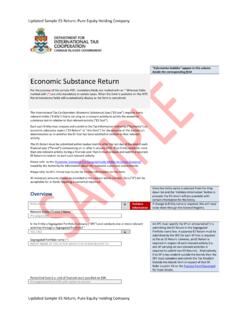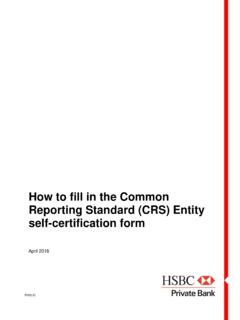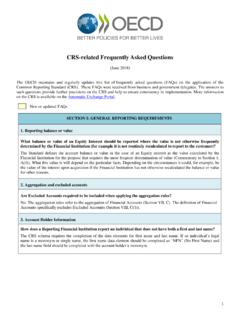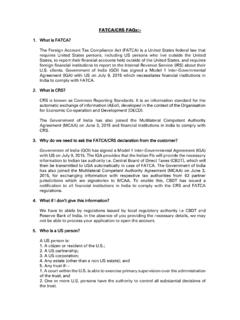Transcription of The Common Reporting Standard for Automatic Exchange …
1 Tax Information Authority CAYMAN ISLANDS The Common Reporting Standard for Automatic Exchange of Financial Account Information in Tax Matters CRS GUIDELINES Issued pursuant to Regulation 5A of the Tax Information Authority (International Tax Compliance) ( Common Reporting Standard ) Regulations, 2018 Date of Issue: 6 November 2020 Version CRS Guidelines Version replaces the previous Version issued 15 March 2018 1. LEGISLATIVE FRAMEWORK .. 1 A. Overview .. 1 B. Exchange Agreements .. 1 i. Core Documents .. 1 ii. Key dates under the CRS .. 1 C. Domestic Law .. 2 D. Cayman Islands Competent Authority .. 2 i. Information requests under the TIA Law.
2 2 ii. Compliance with an Information Request by the Authority .. 2 E. DITC Portal .. 3 i. Confidentiality .. 3 F. Interpretation of the CRS Guidelines .. 3 2. ENTITY CLASSIFICATION .. 4 A. Misclassification of an Entity .. 4 i. Misleading & Inaccurate Information Offences .. 4 ii. 4 B. Entity Classification Flow Chart .. 4 i. Definition of an Entity .. 5 ii. Is the Entity resident in the Cayman Islands? .. 5 iii. Is the Entity a Financial Institution? .. 6 iv. Is the Entity a Non- Reporting Financial Institution? .. 8 C. Non-Financial Entities .. 8 i. Active NFE .. 9 ii. Passive NFE .. 9 3. FINANCIAL ACCOUNTS .. 10 A. Excluded Accounts.
3 10 i. Dormant Depository Accounts are Excluded Accounts .. 10 B. Accounts that need to be reviewed .. 10 i. Depository Accounts .. 10 ii. Custodial Accounts .. 10 iii. Equity and Debt Interests .. 11 iv. Cash Value Insurance Contracts .. 11 v. Annuity Contracts .. 11 C. Reportable Jurisdictions .. 11 i. Jurisdiction where the FI maintains its accounts .. 11 D. Reportable Financial Account Flow Chart .. 12 i. Reportable Account by virtue of the Account Holder .. 12 ii. Reportable Account by virtue of the Account Holder s Controlling Persons .. 13 E. Non-Reportable Financial Accounts .. 15 i. Financial Accounts of investment managers and 15 F.
4 Account-specific Issues .. 15 i. Undocumented Accounts .. 15 ii. Limited Life Debt Investment Entities .. 15 iii. Determination of Equity Interest in the case of a widely-held Collective Investment Vehicle that is a Reporting Financial Institution .. 15 iv. Segregated Portfolio Companies, Umbrella Funds and Multi-issuance Entities .. 15 v. E-money providers qualification as a Depository Institution .. 16 vi. Indirect distributions by a trust .. 16 vii. Group Cash Value Insurance Contracts or Group Annuity Contracts .. 16 viii. Holding companies and similar vehicles .. 16 ix. Cayman Islands retirement and pension funds .. 17 4. DUE DILIGENCE POLICIES & PROCEDURES.
5 18 A. AML/KYC for CRS purposes .. 18 i. Look-through requirement for widely-held Collective Investment Vehicles and pension funds in the form of trusts in Non-Participating Jurisdictions .. 18 B. Pre-existing Accounts .. 19 i. Pre-existing Individual Accounts .. 19 ii. Pre-existing Entity Accounts .. 20 iii. Application of New Account procedures to Pre-existing Accounts relationship manager inquiry .. 20 C. New Individual/Entity 21 D. CRS Self-Certifications .. 21 i. Template Forms .. 21 ii. Confirming the validity of self-certifications .. 21 iii. False self-certifications .. 22 E. Examples of written policies and procedures.
6 22 i. No delegation of CRS obligations .. 22 ii. Delegation of CRS obligations .. 22 iii. Segregated Portfolio Companies, Umbrella Funds and Multi-issuance Entities .. 23 iv. Trustee of Trustee Documented Trusts .. 23 F. Record-keeping .. 23 5. Reporting OBLIGATIONS OF CAYMAN FINANCIAL INSTITUTIONS .. 24 A. Annual Deadlines .. 24 B. Registration on the DITC Portal .. 24 i. Required Information for Registration on the DITC Portal .. 24 C. Authorised Users on the DITC Portal .. 26 i. Institutional User .. 26 ii. Authorising Person .. 26 iii. Principal Point of Contact .. 26 iv. Secondary Users .. 26 D. CRS Reporting .. 26 i. Required Information for the Account Holder.
7 27 ii. CRS Return 28 E. CRS Filing Declaration .. 29 i. NIL Return .. 29 F. CRS Compliance Form .. 29 i. Required Information for the CRS Compliance Form .. 30 ii. Section-specific Issues .. 32 6. DEACTIVATION FROM THE DITC PORTAL .. 34 A. The FI must be terminated .. 34 i. FIs in liquidation or being wound up cannot be deactivated from the DITC Portal until the FI has been formally dissolved .. 34 ii. FIs that are Active on General Registry cannot deactivate from the DITC Portal .. 35 iii. Reporting can be completed by either the SPC or its individual SPs .. 35 iv. FI should not be deactivated due to a change in service provider.
8 35 B. Evidence of Termination .. 35 7. COMPLIANCE & ENFORCEMENT .. 36 A. Offences under the TIA Law .. 36 B. Administrative Penalties .. 36 i. Offences under the CRS Regulations .. 36 ii. Liability of Directors etc. of a Cayman Financial Institution .. 37 iii. Defences & 37 C. Administrative Penalty Procedure .. 37 i. Breach Notice .. 38 ii. Penalty Notice .. 38 iii. Continuing Penalty .. 38 D. 38 E. Interest .. 39 F. Summary of Offences and Liability under the CRS Regulations .. 39 Table of Abbreviations AEOI Automatic Exchange of Information AML/KYC Anti-Money Laundering / Know Your Customer AP Authorising Person CAA Competent Authority Agreement CIMA Cayman Islands Monetary Authority CIV Collective Investment Vehicle the Convention Multilateral Convention on Mutual Administrative Assistance in Tax Matters CRS Common Reporting Standard CRS (Amendment) Regulations Tax Information Authority (International Tax Compliance) ( Common Reporting Standard ) (Amendment) Regulations, 2020 CRS Regulations Tax Information Authority (International Tax Compliance) ( Common Reporting Standard ) Regulations (2018 Revision)
9 DITC Department for International Tax Cooperation FATCA Foreign Account Tax Compliance Act (United States of America) FATF Financial Action Task Force FI Cayman Financial Institution GIIN Global Intermediary Identification Number (United States of America) GP General Partner GR General Registry of the Cayman Islands the Islands Cayman Islands (Grand Cayman, Cayman Brac, Little Cayman) LLC Limited Liability Company LP Limited Partner MCAA Multilateral Competent Authority Agreement OECD Organisation for Economic Cooperation and Development PPoC Principal Point of Contact Reg. Regulation Reporting FI Cayman Reporting Financial Institution S.
10 Section SP Segregated Portfolio SPC Segregated Portfolio Company TDT Trustee Documented Trust TIA Law Tax Information Authority Law, as amended TIA; Authority Cayman Islands Tax Information Authority TIN Tax Identification Number UK United Kingdom 1 1. LEGISLATIVE FRAMEWORK A. Overview The CRS is the global Standard for the Automatic Exchange of Financial Account information for tax purposes and was developed by the OECD on the mandate of the G20. The CRS builds on the intergovernmental approach adopted by many jurisdictions for the implementation of the United States FATCA, but there are key differences to note between the two regimes.












